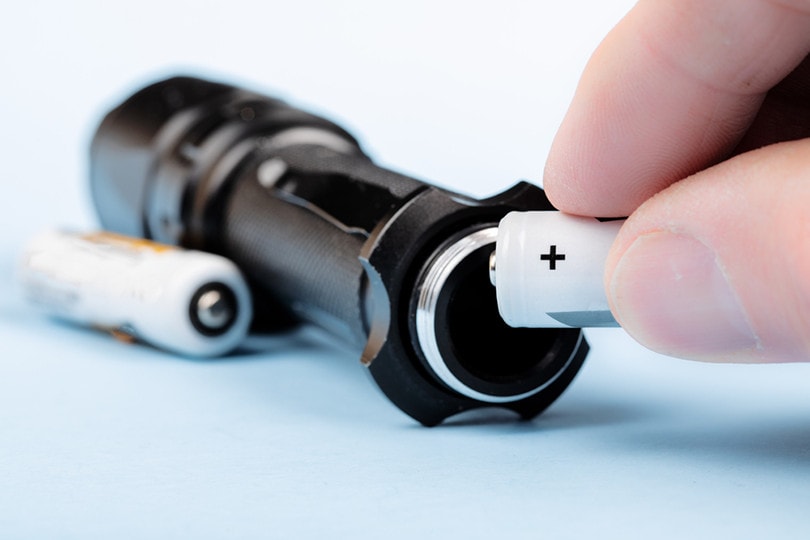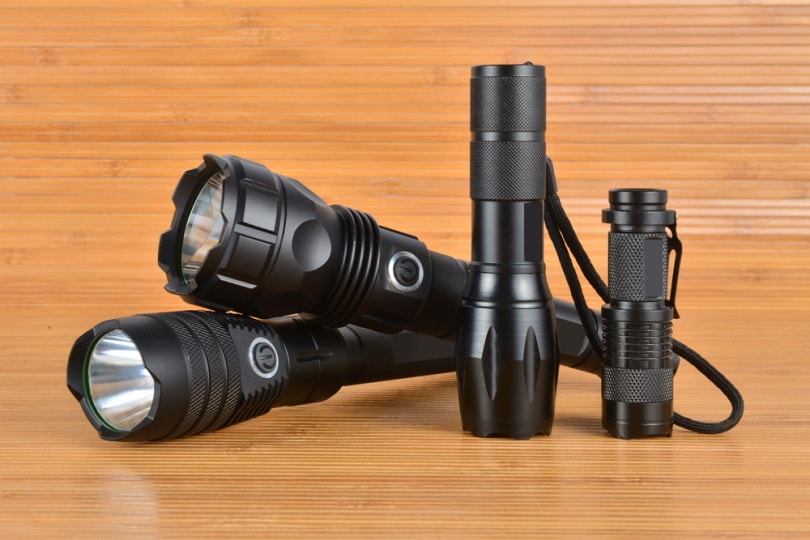How to Get Corroded Batteries Out of a Flashlight in 7 Steps
Last Updated on

Flashlights are relatively inexpensive, but that doesn’t mean you should throw one away because corroded batteries are preventing you from using it. It’s bad for the environment, takes at least some time to buy a new one, and you likely already have everything you need to be able to get the damaged batteries out and leave your existing flashlight in good working order.
Below are seven simple steps to recover your flashlight.

Safety Precautions
It is better to be safe than sorry. Battery acid is corrosive and is an irritant when it comes into contact with skin. It can cause serious problems if it gets in your eyes or mouth. Therefore, it is a good idea to wear protective gloves and goggles.
The 7 Steps to Getting Corroded Batteries Out of a Flashlight
1. Remove the Headpiece or Cover
Different flashlights are designed differently, so you will either have to remove the rear cover or the headpiece, depending on how you get into the battery compartment.
2. Pour in Baking Soda and Vinegar Solution
Make a solution of baking soda and vinegar. You shouldn’t need too much of the solution—a tablespoon of each should be enough. The solution will neutralize the acidic solution coming from the battery, subsequently loosening it and freeing the battery from its temporary hold.
Pour the solution into the battery compartment of the torch.
3. Cover With Tin Foil
Once the vinegar solution does its job, it will mix with the battery acid. The resulting liquid will not be as acidic as it was, but it can still cause a mess. Use clean tin foil and cover the open section of the battery. This will be at either the headpiece or the rear compartment that you removed earlier.
4. Give It a Shake
Once the tin foil is securely in place, give the battery a gentle shake. This will help disperse the liquid around the battery compartment, ensuring that it gets in between the batteries and between the battery and the other components. Do make sure you’re wearing gloves at this point because some liquid may still escape despite the tin foil protection.
5. Open the Cover
Take off the tin foil and pour the solution out before safely disposing of it. If the batteries did not come out with the solution, you may need to give the flashlight a tap while gently shaking it, but remember that there will still be some acidic liquid in there, so don’t shake too vigorously.
6. Leave It to Dry
Once the batteries are out, use a soft cloth to clean the battery compartment. If you have a small brush, you can use this to get the final remnants of acid and battery out. Once you’ve cleaned everything, leave the flashlight out until it is bone dry.

7. Check That the Flashlight Works
If you discovered the battery corrosion soon after it occurred, you should have avoided any damage to the components of the torch. But if the batteries have been corroded in place for some time, the flashlight may not work properly. Replace the batteries and try turning the torch on to make sure it is still working.
Final Thoughts
Over time, flashlight batteries can discharge hydrogen gas, causing increased pressure within the battery. If the pressure gets too much, it can cause the casing of the battery to rupture, which is when leaks occur. Keeping batteries in a cool, dark environment may help, but even then, a flashlight can suffer from leaking batteries. Above are seven steps to remove corroded batteries from your flashlight safely and, hopefully, prevent the need to buy a new light.
Featured Image Credit: sockagphoto, Shutterstock
About the Author Robert Sparks
Robert’s obsession with all things optical started early in life, when his optician father would bring home prototypes for Robert to play with. Nowadays, Robert is dedicated to helping others find the right optics for their needs. His hobbies include astronomy, astrophysics, and model building. Originally from Newark, NJ, he resides in Santa Fe, New Mexico, where the nighttime skies are filled with glittering stars.
Related Articles:
How to Clean a Refractor Telescope: Step-by-Step Guide
How to Clean a Telescope Eyepiece: Step-by-Step Guide
How to Clean a Rifle Scope: 8 Expert Tips
Monocular vs Telescope: Differences Explained (With Pictures)
What Is a Monocular Used For? 8 Common Functions
How to Clean a Telescope Mirror: 8 Expert Tips
Brightfield vs Phase Contrast Microscopy: The Differences Explained
SkyCamHD Drone Review: Pros, Cons, FAQ, & Verdict
